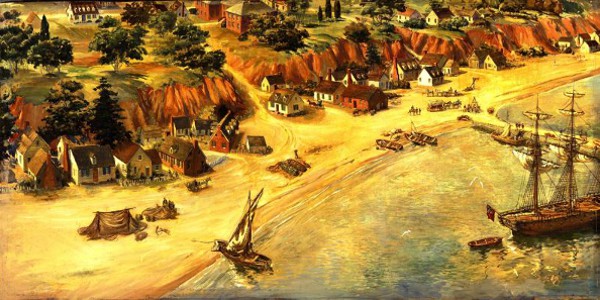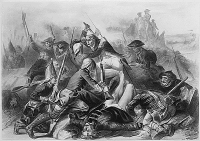
Picture above: Period interpreters at Colonial National Historic Park, photo courtesy National Park Service.

Colonial National Historic Park - Yorktown
One of the least realized facts in American history is the time it took for the Continental Army of George Washington to win the War of Revolution. When the final major land battle of Yorktown had been won, it had been over six years since the Declaration of Independence had been shouted from the streets in Philadelphia to the new nation. Even after Cornwallis had surrendered at Yorktown on October 19, 1781, the days of fighting amongst the variety of combatants now on the side of the American Revolution, forming the new government, of drafting the Constitution, and installing its first president, would take nine years more. It was hard work forming a nation, fifteen years of hard work, one based on equality, and democracy, and freedom. What the men of the Revolutionary Army with General George Washington essentially began at the Battle of Yorktown was an experiment of historic proportions, which continues today.
Click here to Sponsor the page and how to reserve your ad.

Yorktown Then
The Revolutionary War took place among a small group of soldiers, approximately 15,000 on each side. It was contested along the eastern seaboard, from Bunker Hill to Saratoga to Montreal. There were battles across the state of New Jersey at Princeton and Trenton, and campaign in the south and West from Charleston to Vincennes. It would all culminate at Yorktown, five years after the first shot had been fired on April 19, 1775. Washington had been given the French troops under Lt. General Jean de Rochambeau and the combined forces headed into Virginia to confront Cornwallis at his base of operations at Yorktown. By September 28, 1781, Washington's force of 17,000 men had surrounded the city. His attack began on October 6, and the siege preventing food and supplies went into effect. Without a route for escape, Cornwallis had no other recourse than to surrender his 8,000 men to Washington. This act caused the British Prime Minister, Lord North, to resign his position, and the new government to begin negotiations for peace.
Historic Dates of the Revolutionary War and U.S. Independence
April 19, 1775 - Revolutionary War begins when Colonial troops clash with British soldiers at Lexington, Massachusetts.
July 4, 1776 - The Declaration of Independence is pronounced in the streets of Philadelphia.
December 19, 1777 - Washington and his soldiers make winter quarters at Valley Forge.
February 6, 1778 - The French form an alliance with the United States.
October 7, 1780 - American frontier fighters storm the British at Kings Mountain.
October 19, 1781 - British forces under Lord Cornwallis surrender to Washington's American forces and their French allies at Yorktown, Virginia.
January 14, 1784 - Congress ratifies the final peace treaty between Great Britain and the United States, ending the conflict that would give America its freedom.
May 25, 1787 - With George Washington presiding, the Constitutional conventions opens in Philadelphia's Independence Hall.
June 21, 1788 - Ratification by New Hampshire of the United States Constitution, the 9th state to do so, indicates adoption of the document by the United States.
April 30, 1789 - The 1st President, George Washington, is inaugurated in New York City. He had been chosen president by all voting electors (there was no direct presidential election) with John Adams elected Vice President.
January 8, 1790 - The first State of the Union address is given by president George Washington.
Image above: Painting of Colonial Yorktown waterfront in 1781, the busiest seaport in the Chesapeake Bay at the time, Sidney E. King. Courtesy National Park Service. Below: French artillery along the Allies siege line at Yorktown. Courtesy National Park Service.

Yorktown Now
Colonial National Historical Park - This park contains over 8,000 acres on a variety of historic sites from Yorktown to Jamestown. The park has four distinct units; Cape Henry Memorial, Historic Jamestowne, Yorktown, and the twenty-four mile Colonial Parkway that connects them, as well as Williamsburg. This national park is considered to be the Beginning (Jamestown) and End (Yorktown) of English Colonial America.
Yorktown Victory Center - This Virginia state run attraction next door to Colonial National Historical Park contains a recreation of a Continental Army encampment, films, and indoor exhibition galleries.
Minute Walk in History
Although getting to peace in the American Revolution would take two more year with the Treaty of Paris, the battle won by General George Washington and the Continental Army over British General Cornwallis' troops was the final land battle victory that won the war for the United States. Take a walk and ride with us around the Visitor Center and driving tour to see the land where all this democracy started.
T-Shirts and Souvenirs

Yorktown and Colonial National Historical Park T-Shirts and Souvenirs from the official merchandise of America's Best History.

Yorktown
Things You Should Not Miss
1. Both visitors centers at Yorktown and Jamestown have films that will orient you with the sites. Take the time to view them and get your first impression of the history that was made here.
2. Visit the indoor galleries of the Yorktown Victory Center and the effect the war had on ten men and women who witnessed the Revolution.
Image above: Painting of Washington, Rochambeau, and Lafayette at the Siege of Yorktown, 1838. Courtesy National Park Service. Below: Painting of George Washington. Courtesy National Archives.

Visitor FAQ

Image above: Surrender to George Washington of Cornwallis forces at Yorktown, October 19, 1781, 1845, James Baillie. Courtesy National Archives. Below: Military costumes of the American Revolution with George Washington, British, Hessian, French, and Indians in a painting by John Benson Lossing, circa 1876. Courtesy Library of Congress.
Cornwallis himself did not attend the surrender ceremony. His second in command, General Charles O'Hara, actually carried the sword to the surrender.



